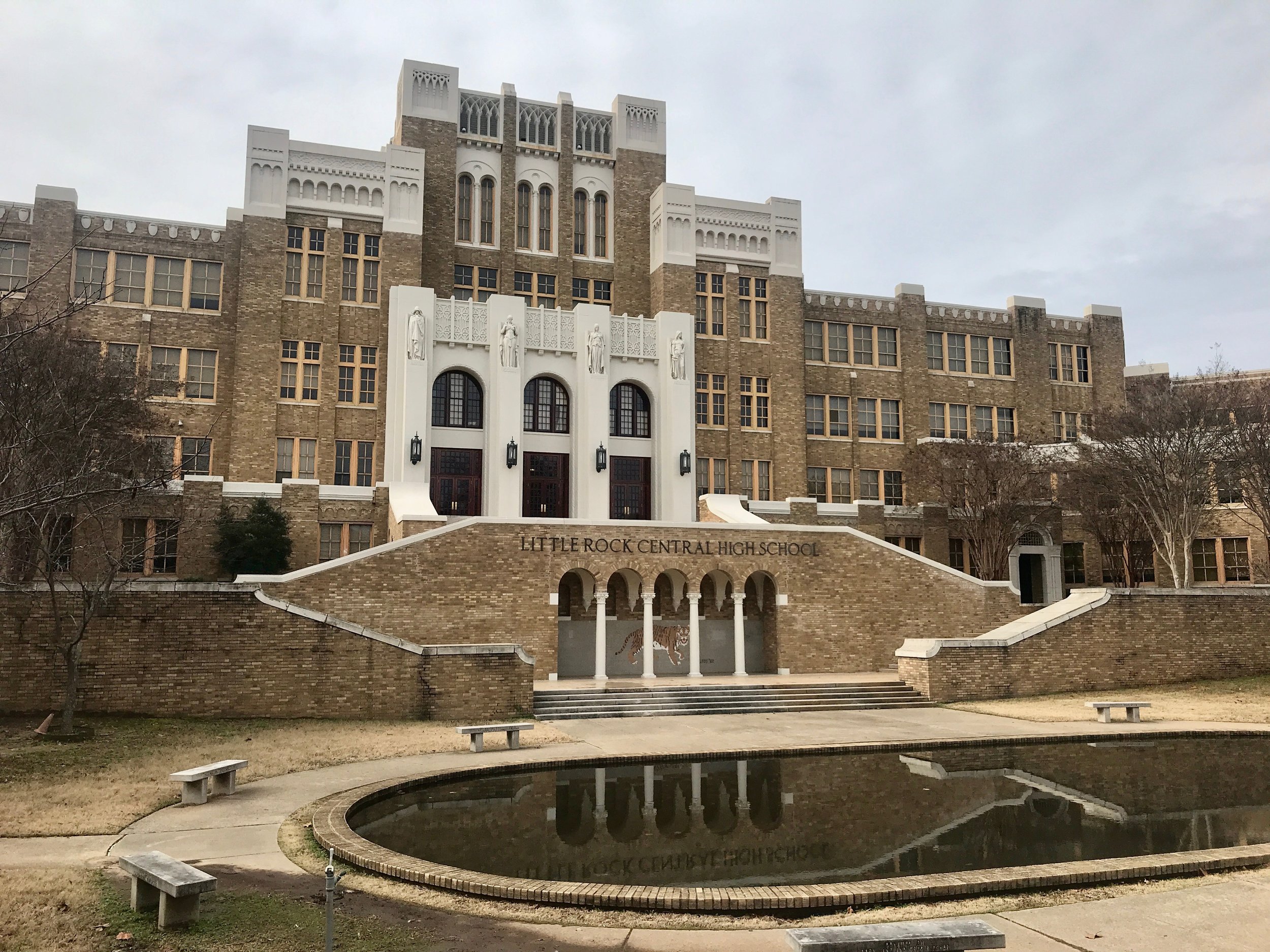The heroes of Little Rock
By Rick Holmes
Dec. 28, 2018
Little Rock, Arkansas – I went to Little Rock Central High School for a history lesson about an ugly moment for Arkansas and the nation. What surprised me was the building’s beauty. Its yellow-brick expanse sprawls up and out from its stately front entry. Over the doors stand four classic sculptures, depicting the ingredients of success: Ambition, Personality, Opportunity and Preparation. In the courtyard below, there’s a reflecting pool, surrounded by nine stone benches.
When Central opened in 1927, it was billed as the largest, most beautiful and most expensive in the country. It had state-of-the-art classrooms and labs. Nothing but the best for the children of Little Rock.
The white children, that is. The black children went to Gibbs High School, which was crowded and falling apart. There was no money to fix it, what with $1.5 million being spent on the new school for the white kids. Gibbs taught industrial trades, making no effort to prepare students for college. Like other schools across the South, it was separate, but far from equal.
When the U.S. Supreme Court declared in 1954 that separate schools for African American students violated the Constitution, the days of the all-white Central High School were numbered.
Little Rock school officials followed the law, laying out plans to gradually integrate the schools, starting with limited number of African American students to be enrolled in Central. Students had to volunteer to be in the first group, and went through a screening process. They had to be serious students, with supportive parents, and not too attractive, the school committee said, to avoid romantic conflicts.
Politics intervened before the black students showed up for the beginning of the 1957-58 school year. Arkansas Gov. Orval Faubus declared schools would not be integrated on his watch. In defiance of federal court orders, he called out the Arkansas National Guard to stop black students from entering Central High.
In a historic test of federal vs. state authority, President Dwight Eisenhower federalized the Arkansas National Guard and ordered them to withdraw. When mob violence broke out in front of Central, Eisenhower sent in the Army to keep the peace. The students – soon to be known as the Little Rock Nine – finally entered Central High School escorted by 25 heavily-armed members of the 101st Airborne.
For days, the conflict played out in front of the magnificent building on South Park Street. The national press was there, often caught between the angry white mobs and the black students. Television was still new technology, and this was the first racial clash TV brought into living rooms across the country.
At the center of this national drama were nine teenagers: Ernest and Elizabeth; Terrence and Minnijean; Melba, Thelma, Jefferson, Carlotta and Gloria Ray.
They were screamed at and spit upon by white crowds waving Confederate battle flags – a banner that stood for hate, not “heritage.” Their families received death threats.
Their trials didn’t end when the national spotlight moved on. They had to live through high school hell, every day, for years: harassed in the hallways, bullied in phys ed. The stress was enormous. The expectations put on them by parents and supporters to be model students with endless patience added to their burdens. But they persevered, and blazed a path thousands of others would follow.
There were many players in this story. Eisenhower and Faubus, the NAACP, for starters. For those who see the struggle for civil rights in black and white, I note that Little Rock’s white mayor and all-white school committee supported integration. The judges who ordered integration were white. So were the editors and publisher of the Arkansas Gazette, who endured death threats and advertiser boycotts for their support of the Little Rock Nine and won a Pulitzer Prize for their withering criticism of Faubus.
But I left Little Rock most impressed by the students. Rosa Parks was a local civil rights activist, well prepared for the abuse she would take for refusing to give up her seat on a Birmingham bus. Jackie Robinson was an accomplished baseball player, chosen to integrate Major League Baseball specifically for his even-tempered disposition. These were kids, with no idea how their story would end.
For many years, nothing at Central High School commemorated the history that happened there. Little Rock even considered putting a wall around the school to block it from public view. But lots of people wanted the story of the Little Rock Nine told. They included Bill Clinton, who was 11 years old when he watched the confrontations from his home less than an hour away from Central High School.
“Seeing the Little Rock Nine face down an angry mob fascinated me and inspired an emotional bond that has lasted a lifetime,” Clinton said later. On the 30th anniversary of the crisis, Gov. Bill Clinton invited them to the governor’s mansion. In 1998, President Bill Clinton returned to Little Rock to designate the school as part of a National Historic Landmark.
Today, Central is still a high school, with more than 2,000 students enrolled, about half of them African American. It’s the home of the Little Rock Tigers, and a mosaic tiger lurks just behind the reflecting pool out front. The stone benches around the pool are a more recent addition. Each bears the name of one of the Little Rock Nine on the front. On the back is the name of a sponsor that underwrote the monument. One of them was given by the Little Rock Central Class of 1953, which graduated three years before integration.
History is vast, and who we choose to remember matters. In Little Rock, we remember the courage of nine teenagers.
Rick Holmes can be reached at rick@rickholmes.net. You can follow his journey at www.rickholmes.net. Like him on Facebook at Holmes & Co, on follow him on Twitter @HolmesAndCo.



